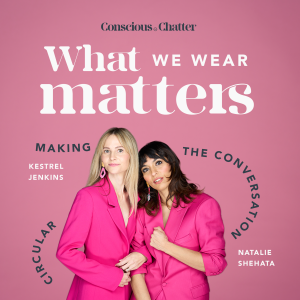
S05 Episode 228 | CATHERINE MCKINLEY, AUTHOR OF THE AFRICAN LOOKBOOK, ON THE DEEP MEANING CONNECTED TO CLOTH, THE POWER OF THE CAMERA AND SEWING MACHINE + RECLAIMING VISUAL NARRATIVES
 2021-03-23
2021-03-23
In episode 228, Kestrel welcomes curator and writer Catherine McKinley to the show. The author of Indigo, a journey along the ancient indigo trade routes in West Africa, and The Book of Sarahs, a memoir about growing up Black and Jewish in the 1960s-80s, Catherine has taught creative nonfiction writing at Sarah Lawrence College and Columbia University. Her newest book, The African Lookbook, A Visual History of 100 Years of African Women, draws on her extensive collection of photos to tell a different visual narrative of African women.
“In most of the societies, cloth is just, it’s essential, it’s considered something that contains the human spirit and it’s the layer next to the skin — you know, it has all those meanings. And cloth is essential from what you’re wound in the moment of birth to what you’re wound in at the grave.”-Catherine McKinley, Writer + Curator
On this week’s show, Catherine shares more on what led her to have an interest in writing, cloth, photographs and fashion. Through our conversation, she reminds us of the layers of meaning that can be embedded in cloth - from culture to identity to wealth to power and beyond.
Catherine also explains more on why she highlights the sewing machine and the camera as the two most important machinery for African women in her book — as she calls them, “steadfast instruments that offered a powerful means to author one’s own life.”
-
”I’m really driven by this idea of holding onto things from the past and things that are disappearing or are ephemeral in some way.” -Catherine
-
Seydou Keïta, photographer
-
Malick Sidibe, photographer
-
Okwui Enwezor, Catherine studied with him
-
The Walther Collection, Catherine worked here in the past
-
“And then I started feeling competitive in a way — these enormously wealthy men who could just acquire and acquire and acquire — you know, every amazing photo document that was coming in, and I started to take it a little bit more seriously. I started doing it in earnest and my collection is primarily women’s photos and I really felt like it’s not theirs, you know. It’s not theirs — I don’t have the access that they have, but to the extent that I can collect, I’m going to collect and I’m gonna claim this and I’m not gonna let it just be our object — I’m gonna think about its use and value to other people, beyond just sitting on a gallery wall.” -Catherine
-
“I was at a dinner with a group of men in the art world — I was the only female there, I was the only non white person there … it was a very male conversation about photography, and I think I blurted out this thing about the sewing machine and the camera, and everybody looked at me like I was crazy — you know, to say they were the most important machinery for African women." And then, I went home and I still felt like this thing is right, I’m right about this, and I don’t have evidence, but … it was kind of what finally organized the book for me — it was like ok how now am I going to prove this argument to these men in particular? Not that I was all that interested in whether they agreed or not, but it just seemed like this really outrageous claim, so how now am I going to make good on it?” -Catherine
-
“Cloth certainly has been one of the absolutely most important commodities for women — if you had access to buy one or two pieces of cloth and put that on your head and walk the street and try to sell it, it was small capital to build up more and more and more.” -Catherine
-
The McKinley Collection, Catherine’s archive representing African photographers from 1870 to the present
-
The African Lookbook
-
Follow Catherine on Instagram >
More Episodes
Create your
podcast in
minutes
- Full-featured podcast site
- Unlimited storage and bandwidth
- Comprehensive podcast stats
- Distribute to Apple Podcasts, Spotify, and more
- Make money with your podcast
It is Free
- Privacy Policy
- Cookie Policy
- Terms of Use
- Consent Preferences
- Copyright © 2015-2024 Podbean.com






